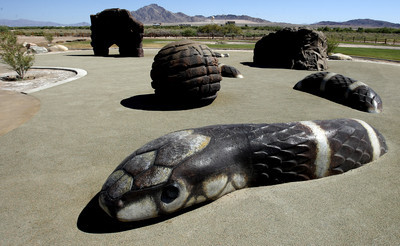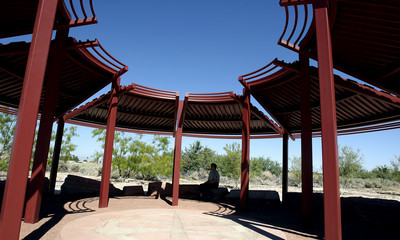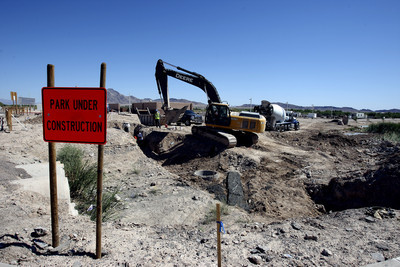upgrading waterways
It's known as an oasis in the desert, where streams burble beneath lush, 7-foot-tall vegetation and birds trill and the air feels surprisingly humid.
A large swath in the Wetlands Park looks as though a Florida savannah was plopped down in the southeast valley. Now the 2,900-acre park, which owes its lushness to the reclaimed water piped in each day, is undergoing $40 million in upgrades, mostly within a 210-acre nature preserve that sits inside the park.
Federal grants, money from a 2000 state bond and regional construction fees combined to pay for the latest additions to the park that was an outcropping of efforts to reverse deep erosion within the Las Vegas Wash.
Clark County is working to build amenities in the park according to a 20-year master plan, said Elsie Sellars, Wetlands Park coordinator.
"We're ahead of schedule," Sellars said.
Most of the master-plan funding to improve the park, located at the east end of Tropicana Avenue, comes from federal land sales made in Southern Nevada. Sellars estimates that the Bureau of Land Management is chipping in about $87 million from that program to cover future work at the park.
The 8-year-old state bond will cover $10 million in costs, including $7 million to build the 30,000-square-foot visitors center, she said.
By year's end, three miles of trails will be added and three miles will be rebuilt, she said, along with construction of ponds and streams.
Another goal is to begin work by 2009 on the visitors center, which will take 18 to 24 months to finish.
The center will feature an interpretive gallery, an auditorium, two classrooms, a research laboratory, a cafe and a 14-foot-high observation deck with a view of the wetlands and surrounding mountain range.
The auditorium will showcase the park's vegetation, wildlife, the Las Vegas Wash and evidence of inhabitants dating back as long as 10,000 years ago.
Meanwhile, the nature preserve is being expanded.
A small neighborhood park will be developed in the preserve. It will have a children's play area with walls and wetlands-themed animals to climb, along with two picnic tables and a shade shelter.
Crews are adding three ponds, connected by streams, and creating new trails that link to existing trails. Also, they will construct a maintenance building and yard behind a cinder-block wall, shrouded by plants.
Outside the preserve, the Duck Creek, Quail Run and Coyote trails are being enhanced. In some spots, workers are applying a resin coating to harden the trails, while in other areas they are building bridges and boardwalks, Sellars said.
Crews are replacing tamarisk trees, a non-native species, with honey mesquite trees, which are indigenous to the area, Sellars said.
Settlers brought tamarisks from the Mediterranean region in the 1930s to act as wind barriers and fence lines, she said. A tamarisk consumes a lot of water and excretes salt into the soil to ward off competing vegetation.
"It's really aggressive," Sellars said.
Mesquite trees are more eco-friendly and foster wildlife, she said, noting that coyotes eat the pods and squirrels gather the seeds.
Given the scant rainfall in the area's desert climate, the park needs water from a man-made source.
An estimated 5 million gallons of reclaimed water is funneled into the park every day, a fraction of the 150 million gallons that stream through the Las Vegas Wash daily, Sellars said.
The Wetlands Park is a testament to the nearly two-decade effort to restore the eroded wash, said Gerry Hester, project manager for the Southern Nevada Water Authority.
Years ago, the water's torrential flow carved deep cavities in the wash and carried heavy sediment into Lake Mead, the area's main supply of drinking water.
The erosion diminished the area's wetlands from 2,300 acres to less than 300 acres by 2000, Hester said.
A $150 million effort to stabilize the wash is about half-done, Hester said. A quarter-cent sales tax combined with federal and state grants pay for the work.
Rocks, known as rip-rap, reinforce the wash as well as streams and ponds within the Wetlands Park, he said. They hold the soil in place and serve as a buffer against erosion.
About 225,000 cubic yards of rubble, now in the wash, have been pulled from quarries, construction sites and imploded casinos, Hester said.
Traces of the Stardust, Westward Ho and other former casinos can be found lining the channel.
Hester said he is happy with the progress made. Sediment flowing into Lake Mead has been reduced by almost 60 percent, he said, adding that the goal is an 80 percent reduction.
"That number is high compared to other stabilization efforts," he said.
Contact reporter Scott Wyland at swyland@reviewjournal.com or 702-455-4519.






























